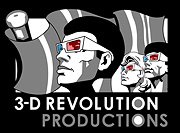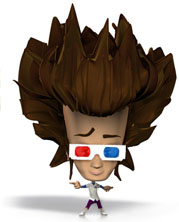Not Keane on this Live 3-D webcast
Keane 3-D Live performance
The verdict
Let me start with a small warning here: this is a negative review of a live Stereoscopic 3-D event. If you are of a mind that all 3-D is good and must not be commented on in a negative way, then look away now. This review is not written for you. If, however, you are a producer or director looking to do a 3-D project and have come away from the live 3-D Keane webcast with a bitter aftertaste in your mouth and would like to know a) why and b) how to avoid this kind of bad 3-D for your stereoscopic project, keep on reading.
The results of BAD 3-D
Yes, live broadcasts are a lot of work and in 3-D they are even more tricky, but provided the hardware is in place (stereo rig, realtime stereo encoders, realtime webast encoders) there is no reason why material should be shot at poor interaxials, underlit, wrongly colour encoded and compressed with codecs that kill the 3-D altogether. Because that is my professional opinion of this production. All hail to digital 3-D and live 3-D broadcasts, but stereography actually does mean delivering pleasant and, where possible, impressive 3-D regardless of any shooting circumstances. And there's no hiding behind stereo lookup-tables when things turn out as flat as a pancake. It's not called 3-D for nothing, you know...
SI 2K Mini cameras in 3-D setup
On the Keane 3-D webcast firstly, and most crucially, the interaxial (interocular, camera distance) is WAY too small on all of the shots. Nice cranes and dollies, Spider Cams and SI Mini cams, but they don't change a thing about the interaxial. What were the Stereoscopic decision makers monitoring this material on; an IMAX screen? Apparently it was a 46'' 3-D Plasma screen - not exactly representative for what the webcast audience at home was looking at. Because, and correct me if I'm wrong here, this is a webcast with a screen size of 407x245. The interaxials of the shoot should have been selected with such a small screen size in mind because this is the way 99.9% of the viewers are going to be seeing the webcast. And that 99.9% of viewers are going to see an image that is practically flat. Unless a flat image is what the director was after here. The set may have been deep, but the back wall is too dark to see and the action happens within a space narrow enough to use an interaxial three times the amount that is used now. On the shots with closeby studio lights or microphone stands a dynamic interaxial should have been used. Yes, difficult to do, but that's what being a 3-D expert company is all about, right?
Actual webcast image size. Crane shot from behind a studio light
Compression on the clip is so high and so unrefined that most of the imagery ghosts. OK, so live webcasting does come with the big issue of compression versus bitrates and server load, versus available codecs and delivery systems. Flash video is of of course most versitile and accessible by the widest possible audience, but its ON2 compression is murder on anaglyph colours and thus very bad for 3-D. Windows Media is a lot nicer, RealVideo does an equally good job and Quicktime streaming does a decent enough compression streaming job as well. So in the case of this live anaglyph 3-D webcast the biggest question is: should we try and ensure a quality delivery of the 3-D imagery and choose anything other than Flash Video or do we prefer the benefit of a custom video controller in Flash, quality be d@mned? I know what the audience will choose given the option.
Killing compression for anaglyph 3-D with Flash Video
The biggest and most obvious problem with the video follows next. There is only one instuction that should be given to actors and band members about to appear in an anaglyph 3-D video: do not show up at the studio wearing blue or red clothing. So of course the main singer of Keane is wearing a blue t-shirt in this video - what elese can he do. Rock & Roll, baby! Or perhaps he just wasn't told this little detail by the producers.
You can wear whatever you like for the 3-D shoot - we'll fix it all in post!
An experienced 3-D expert will bring a fine selection of yellow, brown, purple and green shirts with him for this eventuality, but clearly not the people in charge of the Keane 3-D shoot. Sigh. It was my biggest bugbear with the Missy Elliot 3-D hiphop video of last year: 'Ching-a-ling', where dancers were wearing red, blue, and cyan shirts and no post colour correction had been performed on the material by Disney. No wonder most people in the world now seriously dislike analgpyh 3-D: uncorrected blue and red shirts hurt the eyes - and nobody appears to be correcting the blues or telling the artists!
The Ching-a-ling music video in 3-D: all colours of the rainbow used
In this Keane 3-D video some anaglyph colour correction was done, but it was done very poorly and indiscriminately, where none of the colours are tuned at all but just rammed down a blunt squeeze algorithm. It was probably a menu setting on the Sensio encoder used to colour combine the 3-D image into anaglyph 3-D. But black&white anaglyphs would have looked 10x better than this half-hearted mess!
Anaglyph 3-D colour correction
It is good to try and appease everybody and show colours in anaglyph 3-D, but if you are going to do this, do it right. Because right now it is a very dark, murky image with more black and gray than any other shade of colour.
Can you see what is going on in this shot? Is it in 3-D?
And then there are the deadly high contrasts, with lights and lit areas much too bright and dark spots much too dark. Who was lighting this? Were there stereographers on the set at all when the lights were set up? It is not only ghosting that results from this kind of high contrast lighting, but also loss of 3-D, with better lit objects taking a wrong Z-depth position in relation to the underlit or overlit objects. The end result is just plain bad 3-D.
High contrast strangles any 3-D left in this shot
I am sorry guys, but I have to conclude this 3-D presentation is a very poor one and will serve to do plenty of damage to 3-D overall and anaglyph 3-D in particular. Should you be looking to do a similar presentation in 3-D I can only suggest you consider getting proper 3-D stereoscopic consulting beforehand, especially if you are intending to use the production companies involved in the live Keane 3-D webcast. Get your 3-D shots down the way they should be and learn how to get them, before stepping into the studio or even into a 3-D production meeting.
Contact Alexander Lentjes of 3-D Revolution Productions for more information
www.the3drevolution.com
Shot from 'Watch How We Blow', a 3-D HipHop music video
with consulting from 3-D Revolution Productions![]()
![]()
![]()
![]()
![]()
![]()
![]()
![]()
![]()
![]()
![]()
![]()




